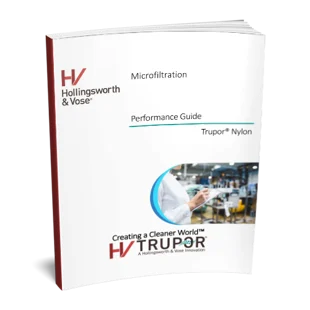Microfiltration Membrane
Microfiltration is used in membrane filtration for the separation and production of products from 5 micron down to 0.10 micron, with most membranes being used between 1.0 micron and 0.2 micron. H&V’s Trupor® product line is available at industry-standard pore sizes—5.0 μm, 1.2 μm, 0.80 μm, 0.65 μm, 0.45 μm, and 0.20 μm.
Due to the crucial nature of the microfiltration processes in their production, membrane reliability and robustness are critical. The microfiltration industry uses proven materials like nylon, polyethersulfone (PES), and polyvinylidene fluoride (PVDF).
Trupor® delivers on H&V’s two centuries of fiber-based innovation and is available in nylon and other polymers. It fills all the conventional expectations of a microfiltration membrane, including:
- Reliable, consistent pore sizes
- All Trupor® products are produced at ISO 9001 facilities under H&V’s adopted version of Hazard Analysis Critical Control Points (HACCP) to meet customer and end application safety expectations
- Diffusion testable
- Fluid treatment without heat, to preserve valuable products
- Chemical-free treatment
- Cost-effective treatment using established processes
- Low protein binding
- Suitable for single-use systems (SuS) or where cleaning is needed
- Cleanable using steam sterilization or gamma irradiation depending on the polymer family
To learn more, ask about our Performance Guide for Trupor® products.
Microfiltration membranes are often integrated with other filtration layers to form a composite; meltblowns, spunbonds, and meshes are commonly used in microfiltration cartridges.
Microfiltration Membrane Applications
Hollingsworth & Vose offers a diverse range of meltblown, membrane, microfiber glass, and composite filter media to suit different industry applications. Typical end-uses include:
- Water filtration. Municipal water and wastewater treatment plants use microfiltration to remove dissolved solids, algae, bacteria, and other impurities. Eliminating extraneous matter at the micron and sub-micron levels reduces turbidity, improves water quality, and minimizes wear on other filtration devices.
- Waterborne pathogen removal. The pores of a microfiltration membrane are smaller than most waterborne bacteria, such as Salmonella, Legionella, and Escherichia coli (E. coli). Microfiltration devices are thus extremely important for filtering contaminants from water and reducing disease. Microfiltration is also effective for removing Giardia and Cryptosporidium, two common protozoan pathogens that, while larger than bacteria, have traditionally been more difficult to remove using standard water treatment processes.
- Industrial filtration. Microfiltration membranes are also effective for gas, air, liquid-liquid, and solid-liquid filtration.
- Semiconductor processing. Electronics manufacturers rely on microfiltration to maintain purer processing liquids, including etchants, plating solutions, and cleaning solvents.
- Chemical mechanical processing (CMP). CMP is particularly important for creating flat, smooth wafer chips. Microfiltration helps CMP achieve greater surface uniformity, which is necessary for accurate lithography, etching, and other fabrication processes.
- Electromechanical deposition (EMD). EMD is a type of CMP that uses an electrolyte solution to deposit metal ions across a material’s surface. Using microfiltration membranes, technicians remove impurities from the EMD bath to ensure the effective dispersion of metal ions onto the substrate.
- Biopharmaceutical production. Clarification and sterilization procedures in the pharmaceutical industry rely on microfiltration to remove microorganisms and contaminants from protein solutions, antibiotics, and immunizations.
- Beer and wine. Food and beverage industries similarly apply microfiltration in their sterilization and clarification processes. Dairy, beer, wine, and fruit juices are just several examples where it’s necessary to remove yeast, bacteria, and other unwanted particulates.
- Ink and dye production. Microfiltration also helps improve ink and dye formulas. By filtering out foreign particulates, manufacturers achieve more consistent colors and overall appearance.
H&V Microfiltration Membrane Form Factors & Mechanisms
H&V microfiltration membranes are used in many form factors:
- Pleated cartridges. By area, conventional industry cartridges at 10-inch lengths are the most common use of microfiltration membranes.
- Analytical and small form factors. Microfiltration membranes are often used in small form factors for analytical and testing capabilities.
- Spiral wound cartridges. Microfiltration is growing in its use of spiral wound elements. Historically, these were mostly used for desalination and reverse osmosis.
Why Choose H&V's Microfiltration Membranes?
H&V is a global manufacturer of advanced materials for filtration applications. By choosing us for your microfiltration membrane filter needs, you benefit from our:
- Superior performance. Trupor® provides superior flux to traditional cast membranes—up to twice the flux of current benchmarks. Trupor® was designed layer-by-layer to deliver the reliability of an existing cast membrane with superior performance.
- Commitment to quality. H&V follows an ISO 9001-certified quality management program and adopts Hazard Analysis Critical Control Points (HACCP) to anticipate the safety and reliability needs of customers and end applications.
- Dedication to innovation. We maintain state-of-the-art manufacturing, testing, and research facilities.
- Global presence. We have R&D and manufacturing facilities in the Americas, Europe, China, and India and sales representatives across the world, enabling local service and product support.
- Customer-focused response. We collaborate with our major customers to create new product solutions that support them and the overall industry.
Microfiltration membranes maintain clean environments and improve the quality of many products crucial to modern life. Hollingsworth & Vose’s innovative Trupor® technology enables faster and more reliable microfiltration in diverse applications around the world. Contact us today to learn more about microfiltration membranes and Trupor® filter media.







